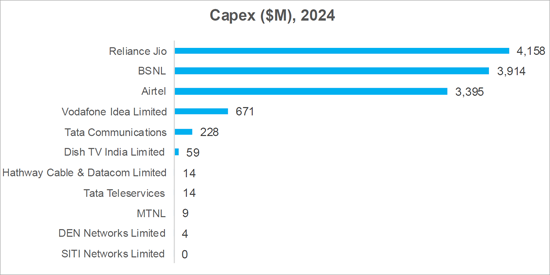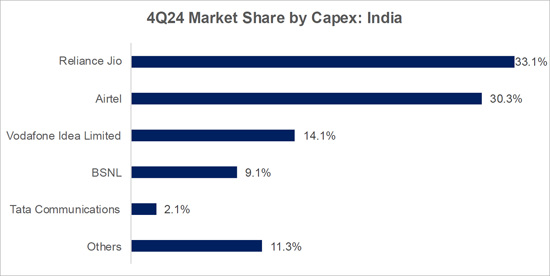|
市場調查報告書
商品編碼
1738472
印度資本支出:2025年第一季三年來首次放緩India Capex Starts to Ease in 1Q25 after 3 Big Years |
|||||||
印度政府正在尋求發展本地供應商生態系統,以便在沒有外部援助的情況下建立智慧安全的電信網路。需要更多支出來推動新創企業的發展。
本報告探討了印度電信業資本支出 (CAPEX) 的近期前景,分析了當前支出趨勢與先前基於主要營運商(例如 Airtel、BSNL、Jio Platforms 和 Vodafone Idea (Vi))2025 年第一季度財務業績的預測有何不同,並概述了影響投資決策的關鍵因素。報告還涵蓋了對供應商的影響以及人工智慧、大型語言模型 (LLM) 和資料中心等新領域的發展。
視覺
圖2:印度的主要設備投資支出企業
CY24 vs 4Q24 ($M and % total)


出處MTN諮詢
2024年,印度電信業將產生140億美元的資本支出和410億美元的收入,分別佔全球總額的4.7%和2.3%。印度的資本支出與收入比率(資本密集度)已連續第三年超過30%。然而,儘管該行業規模龐大且具有戰略重要性,但印度許多主要電信業者已表示計劃在未來幾年內縮減資本支出。這一趨勢符合我們的預測,但與印度政府的政策目標相反。
新的政策措施旨在培育一個充滿活力的國內電信技術生態系統,使其資金更加充足,也更具前瞻性。但開發下一代電信設備的國內新創公司需要在現實環境中進行測試和改進。但隨著營運商為了恢復獲利而縮減預算,這些機會正在減少。
如果情況繼續這樣發展,印度的創新目標可能會受到損害。切實可行的短期解決方案包括政府在BSNL大規模部署全覆蓋5G網路方面發揮領導作用,在全國範圍內部署5G網路時給予Vi優先待遇,以及提供補貼和激勵措施,以提高印度製造的電信設備對海外市場的吸引力。這些措施將支持一些知名的印度新創企業,例如Astrome Tech,Coral Telecom,Frog Cellsat,Galore Networks,Niral Networks,Qbit Labs,Qnu Labs,Prenishq,Resonous Tech,Saankhya Labs,Scytale Alpha,Signaltron,Sooktha,VVDN,WiSig 等。
調查範圍
刊載組織
|
|
|
目錄
摘要
市場背景:印度
2025年第一季的業績
BSNL
Bharti Airtel
Jio Platforms
Vodafone Idea (Vi)
附錄
圖表一覽
The government aims to develop a local ecosystem of suppliers able to build smart & secure communications networks without foreign help. More spending is needed to give the startups a boost.
This brief examines the near-term outlook for telecom capital expenditures (capex) in India, based on the 1Q25 earnings of key operators: Airtel, BSNL, Jio Platforms, and Vodafone Idea (Vi). It analyzes how current spending patterns compare with previous forecasts, highlights the main forces shaping investment decisions, explores implications for vendors, and discusses trends in emerging areas such as AI, large language models (LLMs), and data centers.
VISUALS
Figure 2: Major capex spenders in India,
CY24 versus 4Q24 ($M and % total)


Source: MTN Consulting
India closed 2024 with $14.0 billion in telco capex and $41.0 billion in revenues, representing 4.7% and 2.3% of global industry totals, respectively. India's capex to revenue ratio, or capital intensity, has remained above 30% for three straight years. Yet despite the sector's scale and strategic importance, most Indian telcos are now guiding capex downward over the next few years. That trend is aligned with our forecasts, but at odds with the Indian government's policy ambitions.
New policy initiatives aim to foster a vibrant domestic telecom tech ecosystem, better funded and more forward-looking than past efforts. But local startups developing next-gen telecom gear need real-world opportunities to test and refine their solutions. Those opportunities are set to shrink as telcos tighten their budgets to restore profitability.
Absent a shift in trajectory, India risks undercutting its own innovation goals. The most practical near-term solution? A government-led push for BSNL to deploy true 5G networks at scale, favorable treatment for Vi as it attempts to build out nationwide 5G, plus subsidies and other enticements aimed to make local Indian gear attractive to overseas buyers. That would help such Indian startups making waves like Astrome Tech, Coral Telecom, Frog Cellsat, Galore Networks, Niral Networks, Qbit Labs, Qnu Labs, Prenishq, Resonous Tech, Saankhya Labs, Scytale Alpha, Signaltron, Sooktha, VVDN, and WiSig.
Coverage
Organizations mentioned:
|
|
|
Table of Contents
Summary
Market background - India
1Q25 results
BSNL
Bharti Airtel
Jio Platforms
Vodafone Idea (Vi)
Appendix
List of Figures and Tables
- Figure 1: Capex forecast for India telco market and recent changes
- Figure 2: Major capex spenders in India, CY24 versus 4Q24 ($M and % total)
- Figure 3: BSNL capex, capital intensity, and share of global capex
- Figure 4: Airtel capex, capital intensity, and share of global capex
- Figure 5: Jio Platforms capex, capital intensity, and share of global capex
- Figure 6: Vodafone Idea (Vi) capex, capital intensity, and share of global capex













